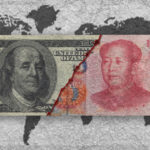Strong Institutional Demand Drives Gold Demand in Q1

(June 10th, 2022 - Andrew Naylor , World Gold Council)
At the end of April, the World Gold Council published our first quarter Gold Demand Trends report, which showed a solid start for the gold market this year, with Q1 gold demand 34% higher than in Q1 2021.
A significant driver of this was strong ETF flows, which at the time of writing, are just shy of their highest ever level. In a quarter that saw the US dollar gold price rise by 8%, gold demand (excluding OTC) increased 34% year-on-year to 1,234 tons – the highest since Q4 2018 and 19% above the five-year average of 1,039 tonnes.
Two key factors driving both the price and demand are surging inflation and the Ukraine invasion. Inflation in many markets is at its highest in decades. Here in Singapore inflation is at a 10-year high – fairly modest when compared to the 20-year high we are seeing in Australia, the 30-year high in much of Europe, and the 40-year high in the US. What’s clear is that inflation is more persistent than policymakers had hoped, and this is one of the reasons institutional interest in gold is higher.
Gold as an inflation hedge
Our research shows that gold can be an effective inflation hedge. The average annual return of 11% in US dollars over the past 50 years, has outpaced the US and world consumer price indices (CPI).
Gold also protects investors against high and extreme inflation. In years when inflation was higher than 3%, gold’s price increased 14% per year on average. This number increased significantly with even higher inflation levels. Over the long term, therefore, gold has not just preserved capital but helped it grow.
Research also shows that gold should do well in periods of deflation. Such periods are characterised by low interest rates, reduced consumption and investment, and financial stress, all of which tend to foster gold demand.
Inflation isn’t the only reason investors allocate to gold though. It is considered a fundamentally strategic asset. It can be a source of returns and in the long run has outperformed many other major asset classes. Its unique demand profile means it performs differently to other asset classes, and its lack of positive correlation to many other assets, particularly in downturns, makes it an effective diversifier. It is also liquid – over US$145 billion is traded every day. And as a physical asset it carries no credit risk when owned outright. Taken together, it has the potential to increase risk-adjusted returns. And this is why many institutions hold a strategic allocation to gold.
Q1 gold demand – key global findings
- Gold ETFs had their strongest quarterly inflows since Q3 2020, fuelled by safe-haven demand. Holdings jumped by 269 tonnes, more than reversing the 174 tonnes annual net outflow from 2021.
- Bar and coin investment was 282 tonnes in Q1, 20% lower than the very strong Q1 2021 but 11% above its five-year quarterly average. Renewed lockdowns in China and historically high local prices in Turkey were key contributors to the year-on-year decline.
- Jewellery consumption lost momentum in Q1: demand was down 7% year-on-year at 474 tonnes. The drop was largely due to softer demand in China and India.
- Central banks added 84 tonnes to global official gold reserves during the first quarter. Net buying more than doubled from the previous quarter but fell 29% short of Q1 2021.
- The technology sector had a steady start to the year: demand of 82 tonnes was the highest for a first quarter since 2018, driven by a modest uptick in gold used in electronics.
ASEAN trends
Closer to home in ASEAN, the picture was a little mixed. Consumer demand was up in Vietnam, Malaysia, and Singapore. This is due to a mix of post-pandemic economic recovery boosting consumer confidence, and in Vietnam’s case, an exiting of the COVID lockdown that took place in 2021. Thailand and Indonesia though saw a drop in consumer demand. Consumers in these markets tend to be more price sensitive, and the higher local gold prices have encouraged consumers to sell and lock in profits.
Vietnam is particularly noteworthy. Jewellery consumption grew 10% year-on-year to nearly 6 tonnes. This is the first year-on-year increase following the last two quarters of year-on-year decline, and the highest first quarter for Vietnam since 2007. Festivities including the New Year celebrations in February, Valentine’s Day and the God of Fortune Day supported the recovery, as has the recovery of business activity to pre-COVID levels. This is reflected in a robust GDP growth figure of over 5% in the first quarter. Bar and coin demand in Vietnam also grew – by 4% year-on-year – for similar reasons.
Other key regional markets:
- Consumer demand in Australia grew 24% year-on-year. This was the first time Australia has been included in out gold demand data series and our estimates suggest Australia is a c28 tonne retail market. Institutional investment in Australia is also a significant component of gold demand, and Australian-listed ETFs grew by almost 5% in the first quarter.
- Japan was more mixed. We saw net selling of bars and coins as consumers – many of them having held gold for a long time – continued to take advantage of the higher gold price and sell. Jewellery demand was up slightly. We are also seeing an increased interest in Japan from younger investors, particularly for gold accumulation plans. The weakening yen is likely to see this interest grow.
- In South Korea, consumer demand was down 16% year-on-year. The main reasons for this are the higher gold prices and also the COVID situation, with cases spiking significantly in Q1 (although now tapering off).
So, whilst it was a robust first quarter this was driven by institutional investment. The consumer demand picture was more mixed. However, as most countries are starting to move on from the pandemic, it is likely that consumer demand will be supported in the remainder of the year, as one of the biggest drivers of retail demand is economic confidence. Institutional investment demand could be more volatile, with a number of tail- and head-winds having an impact. The tug of war between inflation and interest rates, and continued geopolitical uncertainty, will be large factors affecting institutional investment demand for the remainder of the year.






